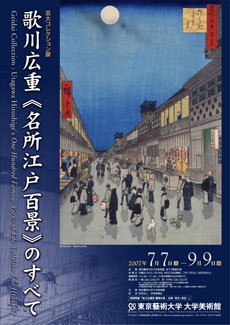Geidai Collection
Utagawa Hiroshige's One Hundred Famous Views of Edo (Meisho Edo Hyakkei) |
| (*A Geidai Collection exhibition is held twice in every academic year.) |
| Dates: |
Jul 7 (Sat) - Sep 9 (Sun), 2007
Closed on Mondays (Except: open on Jul 16 and Aug 27, closed on Jul 17 (Tue) and Aug 25 (Sat))
|
| Hours: |
10:00-17:00 (Entry by 16:30) |
| Place: |
The University Art Museum, B2F, Exhibition Room 1, Tokyo National University of Fine Arts and Music |
The One Hundred Famous Views of Edo, the last masterwork of the ukiyo-e artist Utagawa Hiroshige, is a series of landscape ukiyo-e prints whose subject matter is views of the city of Edo and its outskirts. It is composed of 118 prints designed by Hiroshige I, one print by Hiroshige II and a Table of Content, totaling 120 prints as a complete set. The series, along with his Fifty-three Stations of the Tokaido, is not only the most renowned polychrome woodblock prints of “famous places” by Hiroshige, but also, with its bold compositional contrast between foreground and background and assimilation of the Western linear perspective, represents an apex of the landscape ukiyo-e prints of the Edo period. Its superb artistic quality was also recognized in Europe in the latter part of the 19th century, and the marked influence it exerted on Impressionist and Post-Impressionist painters such as Monet, Van Gogh and Gauguin is well-known. Furthermore, since the Tokyo Association for the Crafts of Traditional Woodblock Printmaking completed its project of reprinting the One Hundred Famous Views of Edo in 2003, the number of exhibitions and publications related to the series has risen. At the same time, new scholarly works on its development of pictorial compositions and its place in a wider historical background have been undertaken in recent years, showing its continuing vitality as an object of research.
The relation of the present set of the One Hundred Famous Views of Edo and Tokyo National University of Fine Arts and Music begins in 1910, when Bunko (predecessor of the University Library) of the Tokyo Fine Arts School purchased the set that was then bound in an album, in which each print was pasted on the page. Since then, the album-bound set had long been managed as a valuable book in the collection of Bunko and the University Library until 2004, when the University Museum held the exhibition Hanga: Waves of East-West Cultural Interchange and some of the prints from the set were put on display. On this occasion, the management of the set was transferred from the Library to the Museum, and the project of removing the prints from the album was initiated. In 2006, after three years of careful restoration work, the removal of all 120 prints was completed.
This exhibition is partly an opportunity to show to the public the entire prints from the set after the completion of their restoration project. We hope you will enjoy watching the unfolding of Hiroshige’s creative process in designing the compositions for his last landscape ukiyo-e series. In addition, as sources of Hiroshige’s ideas for the series, we show various woodblock-printed books of the Edo period. Many of these materials have been collected, stored, and managed by the University Library in the course of the history of the University. At the same time as being an overview of Hiroshige’s last landscape ukiyo-e series, we hope this exhibition will be an opportunity to introduce the University’s long-standing activities of collecting books and art specimens, which started with Bunko of the Tokyo Fine Arts School.
|
| Organized by: |
The University Art Museum, Tokyo National University of Fine Arts and Music |
| Supported by: |
Insatsu Choyokai Foundation |
| In lending cooperation with: |
The University Library, Tokyo National University of Fine Arts and Music |
| In planning cooperation with: |
OKUBO Jun'ichi (National Museum of Japanese History) |
| Admission: |
Adult - 300 (250) yen
Senior high school student and above - 100 (50) yen
Junior high school student and below - Free
*Prices in (): group of over 20 people (one attendant for every 20 visitors is admitted free)
*Free admission for disabled people (one accompanying guest for each disabled person is admitted free)
*The admission ticket to "The Mural Art of Kotohira-gu Shrine -- Okyo, Jakuchu, and Gantai --" also includes admission to this exhibition |
<Inquiry>
NTT Hello Dial: 03-5777-8600 |

